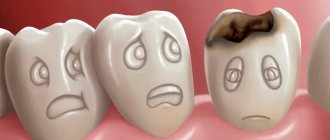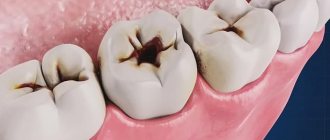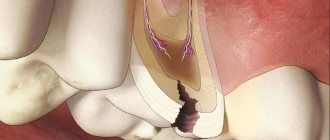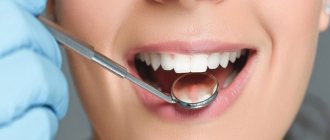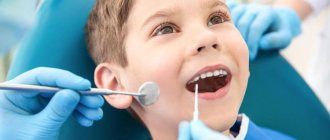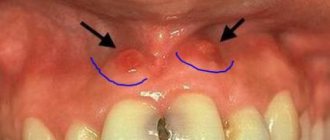How many teeth should a child have?
By the age of three, a child usually already has a full set of twenty primary teeth, and until about 6 years old, their number remains unchanged. Adolescents aged 13 to 18 years should normally have from 28 to 32 molars (depending on the presence of eights, which may erupt after 21 years or not appear at all).
What teeth appear first in children?
The rudiments of baby teeth and even some molars begin to form at the stage of intrauterine development, so modern diagnostic technologies make it possible to track this process and prevent some deviations. After birth, the first teeth usually begin to erupt when the baby reaches six months of age. This means he will soon be ready to eat more solid foods. In the vast majority of cases, the incisors appear first: as a rule, the lower central incisor becomes the “pioneer”.
What can happen if some baby teeth are removed prematurely?
After the removal of a baby tooth, free space appears in the dentition. The body begins to adapt the dentition so that between the teeth there is the largest surface area for chewing food. This is how neighboring teeth begin to shift towards the missing one. When the time comes for permanent teeth to emerge, there will be no room for them. They will “push” neighboring teeth, worsening their position. The tooth can erupt outside the dentition (those “vampire” fangs are a classic of early removal of baby teeth in childhood). Or the tooth may not erupt at all and remain in the jaw (so-called retention).
Due to the removal of a baby tooth and the displacement of neighboring teeth towards the defect, the midline of the dentition may also shift - it does not coincide with the midline of the face. This looks unaesthetic and affects the bite - the closure of the teeth of the upper and lower dentition. All teeth cease to occupy the correct places, which leads to their overload, abrasion of the enamel, and early exposure of the roots of the teeth.
If a baby tooth is removed early, the replacement tooth may be delayed in erupting or erupt prematurely. While there is nothing wrong with delaying teething for 8-12 months, cutting teeth ahead of schedule can be unpleasant. The root and enamel are not yet ready to accept the chewing load.
Child's front teeth
Since a child’s front teeth usually erupt earlier than the rest, they can be used to track how the baby’s body tolerates this process. It can occur in different ways: some children are practically not worried, while others, on the contrary, experience stress and discomfort. Swelling of the gums at the site of the future tooth, itching and pain, as well as a slight increase in temperature are the main negative aspects associated with the appearance of the first teeth. When teething baby molars, children may experience runny nose and cough.
Approximate timing of baby teeth eruption
On average, the first tooth appears at 6-7 months, but sometimes this joyful event occurs earlier - at 4-5 months, or, on the contrary, is delayed. The reason for this, as a rule, is heredity. Therefore, you should not unconditionally rely on generally accepted charts: everything is individual.
In general, the monthly scheme looks like this:
- 6-7 months - most babies have 2 lower incisors in the center;
- 8-9 months – by this age you can expect 2 upper incisors;
- 9-11 months – by almost a year, 2 lateral incisors are visible from above;
- 12-13 months - during this period there are also 2 lateral incisors from below.
So, to the question of how many baby teeth a child should have by the age of one year, we can safely answer: 8.
How do children's teeth grow?
There is no need to panic if the child’s teeth growth does not fit into the above scheme. A delay of 1 - 3 months is considered normal and is associated with the individual characteristics of the body. Children under one year of age often have teeth that do not appear on schedule or may not appear at all. In the latter case, you need to contact your dentist who will help identify the cause.
Teeth in children: order of eruption of baby teeth
The eruption of baby teeth in children is a strictly individual process for each child. Normally, there are deviations of 5-6 months from the stated standards. Most babies begin to cut their first teeth at 6 months, but there are cases where this process begins already in the first three months or only after a year. Moreover, it is not at all necessary that the rudiments be visible at the initial stage. Children's teeth can start cutting in at six months, and the first white bumps will be noticeable by one year.
Standard timing of baby teeth eruption
As a rule, this process begins faster in girls than in boys. In babies with rapid development, the first teeth can be seen at 3-4 months, but it is normal for the process to begin before the age of twelve months. If the timing of the eruption of baby teeth does not correspond to the norm, this is a reason to consult a dentist.
A delay in the natural process may be due to the following factors:
- lack of calcium in the body;
- problems with physical development;
- lack of thyroid hormones;
- metabolic problems;
- edentia – complete absence of the rudiments of baby teeth;
- rickets;
- hereditary predisposition.
Attention! The fact that a child of 1 year is missing primary teeth is not a pathology. Perhaps this is an individual feature. Sometimes parents simply cannot determine the presence of rudiments (the child closes his mouth and does not allow adults to examine the oral cavity). Then a consultation with a pediatric dentist is required, who will conduct a physical examination, assess the condition and give recommendations.
The order of eruption of baby teeth
The standard teething scheme for babies is as follows:
- the incisors in the center come first;
- lateral incisors emerge;
- next – the first molars;
- then fangs;
- The second molars emerge last.
As practice shows, in many children the teeth from below begin to grow first, but there are often cases when the first incisors and molars have already emerged from above, but not yet from below. If an examination by a pediatric dentist and pediatrician shows normal results, you just need to wait a little.
The misconception is that the more calcium in a child’s diet, the faster his teeth will erupt. Many parents begin to introduce cottage cheese, milk porridge, and hard cheese into complementary foods too early, supposedly to speed up this process. In no case should you follow this example to avoid excess calcium in the body and other health problems. Nutrition should be complete, varied, healthy. The time will come, and the teeth will erupt naturally.
By the age of two and a half, the child should have all his teeth: on each half of the jaw there should be two molars, one canine and two incisors. Baby teeth come out symmetrically to each other, there should be 20 units in total, that is, 10 on top and bottom.
Formula for calculating the number of teeth for children under 2 years of age
There is also a formula that can be used to count baby teeth. The order of teething is as follows: the child’s age in months minus six months - the number of teeth is obtained. For example, if a child is 15 months old, then we subtract 6 from 15 and get 9. Accordingly, the baby normally has 9 teeth that have erupted at the moment.
What if the baby was born with teeth already erupting?
It also happens that children are born with already erupted teeth, or they come out in the first few weeks of life. In such cases, it is necessary to seek help from a pediatrician and dentist. Sometimes the presence of incisors and molars interferes with natural breastfeeding, and the child is transferred to artificial feeding, or is fed with a bottle of breast milk and a pacifier.
How can you tell when your child’s teeth have started cutting?
Symptoms of the emergence of the first incisors and other dental units are as follows:
- the baby becomes restless;
- there is excessive salivation;
- the child actively begins to put toys and foreign objects into his mouth;
- baby sucks fingers;
- often asks for a breast or pacifier;
- day and night sleep is disrupted;
- the child becomes whiny and irritable;
- there is a refusal to eat;
- temperature rises;
- The gums are slightly swollen.
Attention! The fact that you do not see the first rudiments of a tooth (a white dot on the gum) does not mean that it is not erupting. On the contrary, the process of coming out is the most painful, and when the tooth appears on the surface, the baby’s condition returns to normal.
Pediatric dentists at the Zuub.rf clinic are ready to provide advice and medical assistance to children during teething. If your child is worried about his teeth, or you have suspicions about the order in which his baby teeth come out, a medical examination with a doctor will definitely help! The dentist will examine the condition of the child’s teeth, give detailed recommendations and rule out pathologies often “contrived” by parents.
Make an appointment at our clinic.
Don't self-medicate! Even the smallest problem, if not treated correctly, can significantly complicate your life.
By contacting us, you can be sure that:
- Get high-quality and free consultation .
- You will receive the best prices for treatment and the opportunity to receive a special promotional price.
- Only modern equipment and materials will be used.
- You will be treated by professional doctors with many years of experience.
- We offer treatment on credit or in installments. There is also the possibility of obtaining a tax deduction.
- We work seven days a week and without a lunch break, from 9 a.m. to 10 p.m.
+7
Tooth growth abnormalities in children
Unfortunately, the development and growth of teeth in children does not always occur as expected: there are a number of anomalies of various types that in one way or another affect the aesthetics and/or functionality of the teeth.
Causes of impaired growth and development of teeth:
- bad heredity;
- fetal injury during pregnancy or birth; intrauterine growth retardation, infections and so on;
- disruption of the endocrine system, thyroid dysfunction;
- lack of vitamins and minerals;
- mechanical, thermal and chemical injuries to teeth;
- bad habits in children that can affect the formation of teeth;
- lack of proper hygiene and poor diet.
Below is a table that describes the most common types of dental anomalies in children.
| Anomaly class | Description |
| Size of teeth | There are microdentia (too small teeth) and macrodentia (too large teeth). The anomaly can affect one or several teeth (and even the entire dentition). |
| Number of teeth | There is partial (lack of several teeth) and complete (absence of all teeth) adentia. Hyperdentia is a supernumerary set of teeth (usually in the second row). |
| Shape of teeth | Cone-shaped, barrel-shaped (Hutchinson's teeth), Pflueger's teeth (the neck is more developed than the coronal part). |
| Anomalies in the structure of enamel and dentin | Hypoplasia (spots and grooves on the body of the tooth), hyperplasia (tubercles, enamel drops, etc.), dentinogenesis imperfecta (violation of the structure and color of dentin). |
| Color irregularities | Enamel pigmentation (gray, black, amber enamel color). Most often it is caused by a disruption of the immune system during the prenatal stage of development. |
| Malocclusion | All types of dental malocclusions: mesial, cross, open, deep and so on. |
Despite the fact that some dental anomalies in children are quite serious, a timely visit to the dentist will help you avoid problems and maintain the health and beauty of your smile. If you let the situation take its course, unpleasant consequences will not keep you waiting.
